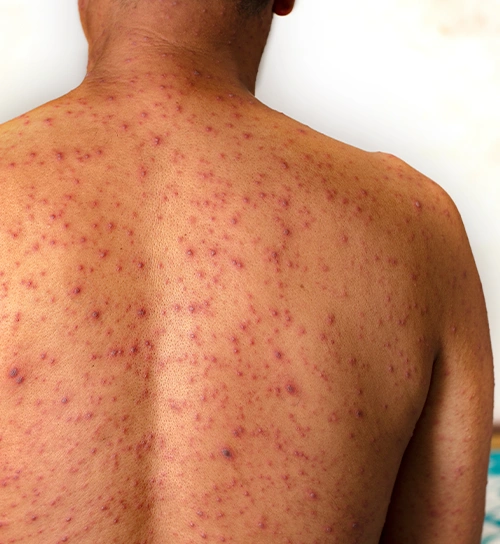Lichen Planus: A Holistic Approach for Lasting Skin Health
Clinically Proven Treatment for Safe & Lasting Skin Recovery
Book your Appointment
Lichen planus is a chronic inflammatory condition that affects the skin, mouth, scalp, nails, and genitals. It causes itchy rashes, discomfort, and pigmentation. Conventional treatments may provide temporary relief, and often fail to identify the root cause, leading to recurrences.
At Dr Batra's®, we have successfully treated over 1.41 lakh skin patients, including those with lichen planus, with a 94.3% success rate. Our holistic, homeopathic approach ensures safe, effective, and long-term relief.
Lichen planus is an autoimmune disorder in which the immune system mistakenly attacks healthy skin cells, causing itchy rashes, painful sores, and discolouration. Conventional treatments offer temporary relief, but at Dr Batra’s®, we go beyond symptom control to treat the root cause for long-term healing.
AI-Powered Diagnosis & Personalised Treatment
Every Lichen Planus case is unique. Our AI-backed analysis helps doctors design personalised treatment plans based on your symptoms, triggers, and medical history
Clinically Proven Homeopathy
Unlike steroids or immunosuppressants, our homeopathic remedies naturally regulate immunity, reduce inflammation, and promote healthy skin repair—without side effects
94% Patient Satisfaction
We have successfully treated thousands of Lichen Planus cases, restoring clear skin and confidence
40+ Years of Expertise
With a legacy of 15 lakh+ patients, our scientific, research-driven approach delivers safe and effective results
Holistic Treatment
Our holistic treatment strengthens immunity, preventing future flare-ups for lasting relief
Homeopathy treats the root cause, reducing flare-ups and long-term skin damage.
Safe & Side-Effect-Free
No steroids, no harmful chemicals.
Long-Lasting
Strengthens immunity to prevent recurrences
Personalised
Tailored to your lichen planus symptoms, lifestyle, and triggers
Effective for All Types
Works for skin, oral, nail, and scalp lichen planus
Lichen planus (LP) is a chronic inflammatory skin disease characterised by dark, raised, flat-topped lesions in clusters or rows. It can affect the skin, scalp, nails, and mucous membranes and lead to itching, burning, and pain.
This autoimmune condition is believed to be triggered by immune system dysfunction, medications, viral infections (HCV), or allergic reactions. Due to its unpredictable nature, a holistic treatment approach is crucial.

Lichen Planus manifests differently across body parts. The main types include:
Cutaneous Lichen Planus
Purplish, itchy bumps on the skin
Oral Lichen Planus
White patches, sores, and redness in the mouth
Vulval and Penile Lichen Planus
Affects genital areas, causing discomfort and soreness
Nail Lichen Planus
Leads to nail thinning, ridges, and discolouration
Lichen Planopilaris (Scalp Lichen Planus)
Causes hair loss and scalp inflammation
Lichen Planus Pigmentosus
Results in dark, pigmented patches on the skin
Lichen Planus Actinicus (LPA)
Triggered by sun exposure, leading to pigmented lesions
Lichenoid Drug Eruption
Medication-induced lichen planus
Bullous Lichen Planus and Lichen Planus Pemphigoides
Rare types causing blisters
Think Twice Before Relying on Steroids! While they offer temporary relief, long-term use thins your skin and doesn’t stop recurrence. Homeopathy heals naturally—without side effects!

Lichen Planus can affect anyone, but it is more common in:
Middle-aged adults (30-60 years)
Women, as per the American Academy of Dermatology
Individuals with immune disorders or viral infections (e.g., Hepatitis C)
Those with stress, allergies, or medication reactions
The exact cause is unknown, but research suggests possible triggers like:
Autoimmune Reaction
The immune system mistakenly attacks healthy skin cells
Hepatitis C Infection
Many HCV patients also have lichen planus
Medication Sensitivity
Drugs for hypertension, inflammation, or infections can trigger reactions
Metal Fillings
Dental fillings can trigger oral lichen planus due to injury
Genetic Factors
Some types, like Bullous Lichen Planus, may be inherited
Diagnosing Lichen Planus involves:
Clinical Examination
Identifying lesions, patterns, and affected areas
Skin Biopsy (If Needed)
Confirming autoimmune inflammation
Blood Tests
Checking for Hepatitis C or immune disorders
No, lichen planus is not contagious. It is an autoimmune condition and does not spread from person to person.
Results vary, but most patients see improvement within 6-8 weeks, with steady healing over time.
Homeopathy works by treating the root cause so that results may vary. Most patients see improvement within 6-8 weeks, with continued healing.
No, homeopathic medicines are 100% safe, natural, and free from side effects. They gently restore balance without causing dependency or skin thinning.
Yes! Homeopathy effectively treats oral lichen planus by reducing inflammation, healing mouth sores, and preventing recurrences—without harsh steroids or chemicals.
Allopathy suppresses symptoms using steroids or immunosuppressants, which may lead to side effects. Homeopathy corrects immune imbalance, addressing the root cause for long-term relief.
Yes! Homeopathy strengthens immunity, naturally reducing flare-ups and preventing recurrence, unlike conventional treatments, which offer only short-term relief.